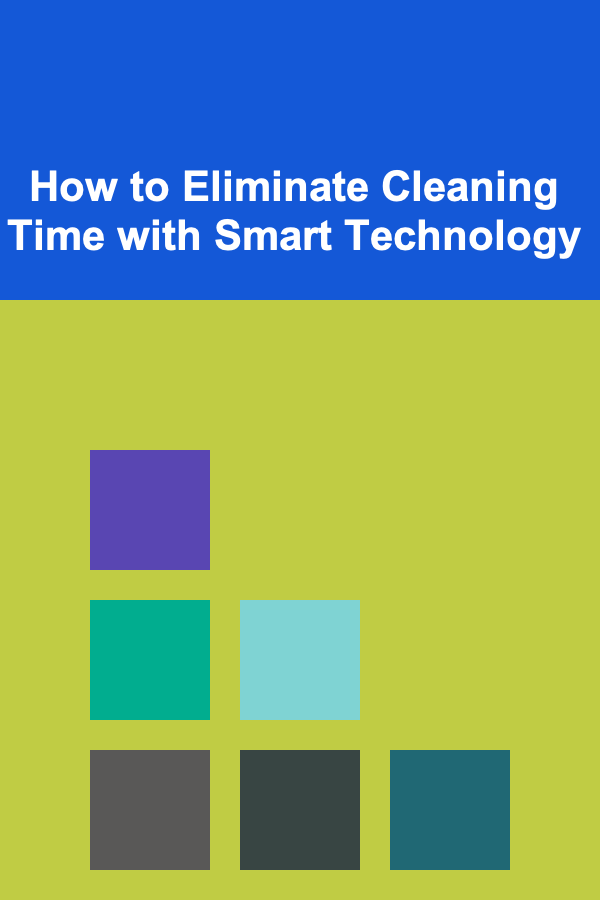
How to Eliminate Cleaning Time with Smart Technology
ebook include PDF & Audio bundle (Micro Guide)
$12.99$5.99
Limited Time Offer! Order within the next:

Cleaning your home can often be time-consuming and exhausting. Traditional cleaning methods require significant effort, from vacuuming and scrubbing to organizing and dusting. For many, cleaning becomes one of the least enjoyable chores on their to-do list. Fortunately, advancements in smart technology have made it easier than ever to automate, simplify, and speed up cleaning tasks. By integrating smart devices into your daily cleaning routine, you can significantly reduce the amount of time spent cleaning while maintaining a neat and hygienic living space.
In this article, we will explore how smart technology can help eliminate cleaning time by using innovative devices, systems, and apps. We will cover various smart cleaning tools such as robotic vacuums, self-cleaning appliances, and connected devices that all contribute to a more efficient cleaning experience. Furthermore, we will delve into how to create an integrated smart home cleaning system that works seamlessly to handle the routine tasks you once spent hours on. From managing household chores remotely to automating mundane tasks, smart technology is revolutionizing the way we clean.
The Role of Smart Technology in Cleaning
Smart technology refers to devices that can connect to the internet or your home network, enabling remote control, automation, and communication with other devices. These devices leverage data, sensors, and artificial intelligence to perform tasks more efficiently, often with little or no input from the user. In the context of cleaning, smart technology allows you to reduce human intervention and optimize household maintenance.
The integration of smart devices into the cleaning process provides numerous benefits. These benefits include reducing physical effort, increasing cleaning precision, and enabling greater convenience. With the rise of the Internet of Things (IoT) and the increasing sophistication of artificial intelligence, smart cleaning devices are becoming increasingly capable of performing a wide range of tasks that would otherwise require considerable time and energy.
Key Benefits of Smart Technology for Cleaning
- Time Savings: By automating routine tasks such as vacuuming, dusting, and laundry, smart devices can save you hours of cleaning each week.
- Efficiency: Smart devices are often more efficient than traditional methods. They can clean hard-to-reach places, work continuously without supervision, and operate with minimal energy consumption.
- Convenience: Remote access and voice control through smart assistants like Amazon Alexa and Google Assistant allow you to clean your home with minimal physical effort or direct involvement.
- Customizability: Many smart cleaning devices allow you to program cleaning schedules, set specific cleaning modes, and adjust settings to meet your specific needs.
Smart Technology for Home Cleaning
Now, let's dive into the key smart devices and systems that can help you eliminate cleaning time in your home. From robotic vacuums to self-cleaning appliances, these innovations are designed to reduce the physical effort and time spent on cleaning.
1. Robotic Vacuums
One of the most popular and widely used smart cleaning devices today is the robotic vacuum cleaner. These devices can autonomously clean your floors, removing dust, dirt, and pet hair, without requiring manual intervention. Robotic vacuums are equipped with sensors and AI to navigate around obstacles, map your home, and optimize cleaning routes. Many robotic vacuums can even be scheduled to clean while you are away, ensuring that your floors are spotless when you return home.
Some of the leading brands in the robotic vacuum market include Roomba (iRobot), Ecovacs, and Roborock. These vacuums are equipped with features like:
- Automatic Charging: When the battery runs low, the vacuum automatically returns to its charging station, ensuring it is always ready for the next cleaning session.
- Scheduling: You can set cleaning schedules for the vacuum to operate at specific times or days, meaning you don't even have to think about it.
- Smart Navigation: Most models feature advanced sensors and mapping technology to ensure thorough coverage of your home, avoiding obstacles and identifying areas that need more attention.
- Integration with Smart Home Systems: Many robotic vacuums can be connected to smart home ecosystems like Google Home or Amazon Alexa, allowing for voice control and remote operation.
The time savings from using a robotic vacuum are immense. These vacuums can handle daily floor cleaning tasks on their own, giving you more time to focus on other household chores or personal activities.
2. Smart Mops
While robotic vacuums are excellent at cleaning floors, they often can't handle wet cleaning tasks like mopping. Smart mops combine the technology of robotic vacuums with the functionality of traditional mopping to provide a more complete floor cleaning solution. These devices can vacuum and mop simultaneously or at different intervals, ensuring that both dry dirt and sticky spills are cleaned up efficiently.
Many smart mops have features that make them even more efficient and user-friendly:
- Water Tank and Cleaning Solution Dispensers: Smart mops are equipped with water tanks that dispense just the right amount of water and cleaning solution during mopping sessions. Some models even allow you to adjust the cleaning solution's strength, based on the type of surface being cleaned.
- AI and Sensors: Just like robotic vacuums, smart mops are equipped with sensors that help them avoid obstacles, map the floor, and efficiently cover the entire area without missing spots.
- Self-Cleaning Features: Some smart mops feature self-cleaning mechanisms that allow them to rinse or clean their mop heads automatically, preventing the spread of dirt or germs.
- Customizable Cleaning Schedules: You can schedule mopping sessions based on your specific needs, whether it's weekly, bi-weekly, or daily cleaning.
Examples of popular smart mops include the iRobot Braava and Xiaomi Roborock S7, which offer top-tier performance in terms of smart navigation, cleaning ability, and efficiency.
3. Self-Cleaning Appliances
Certain household appliances, such as washing machines, dishwashers, and ovens, can also benefit from smart technology. Many modern appliances come with self-cleaning features that save time and effort, ensuring that they remain hygienic and functional with minimal input.
For instance:
- Smart Dishwashers: Many dishwashers now come with smart capabilities that allow you to start and stop cycles remotely via your smartphone. Some models even feature self-cleaning filters, water-saving modes, and automatic detergent dispensing.
- Self-Cleaning Ovens: Self-cleaning ovens use high heat to burn off grease and food residue, leaving the interior clean without the need for harsh chemicals. Some smart ovens can also be monitored and controlled remotely, allowing you to schedule cleaning cycles while you're away from home.
- Washing Machines with Smart Features: Smart washing machines allow for remote control, laundry cycle management, and energy-saving features. Some models even alert you when your laundry is done, so you can keep up with laundry tasks without constantly checking on the machine.
With these self-cleaning appliances, much of the labor-intensive work involved in maintaining household appliances is eliminated, saving you valuable time.
4. Smart Home Cleaning Systems
An emerging trend in home cleaning is the integration of various smart devices into a unified cleaning system. A smart home cleaning system works by connecting devices such as robotic vacuums, smart mops, air purifiers, and self-cleaning appliances through a central hub or app. This allows for seamless control and monitoring of the cleaning process in your home.
For example, a smart home cleaning system may include:
- Integrated Scheduling: You can schedule cleaning tasks for multiple devices at once. For instance, you could set your robotic vacuum to clean the floors, your smart mop to clean the kitchen, and your air purifier to work in the living room---all at the same time.
- Automated Task Coordination: Through smart home apps, you can coordinate the actions of different devices. For example, after your robotic vacuum finishes cleaning the floors, the smart mop could automatically start its cleaning cycle, ensuring that every surface is cleaned without needing your direct involvement.
- Monitoring and Notifications: Many smart home cleaning systems send notifications to your phone when tasks are completed, or when there are issues that need attention, such as low battery levels or clogged filters.
- Voice Control: With integration with voice assistants like Amazon Alexa or Google Assistant, you can control multiple devices at once using voice commands. For instance, you can simply say, "Alexa, clean the house," and your smart system will take care of the rest.
Examples of smart home cleaning systems include Google Home , Amazon Alexa , and Apple HomeKit, which offer a range of devices that work in tandem to streamline your cleaning routines.
5. Smart Air Purifiers and Humidifiers
While air purifiers and humidifiers aren't traditionally part of the cleaning process, they play an important role in maintaining a clean and healthy environment. Smart air purifiers are equipped with sensors that monitor air quality and automatically adjust their settings based on environmental conditions.
These devices can be programmed to run continuously or only when needed, removing allergens, pollutants, and pet dander. Additionally, they are often connected to apps that allow you to monitor air quality in real-time and make adjustments from your smartphone.
Popular brands such as Dyson and Levoit offer advanced air purifiers with smart capabilities, allowing for a cleaner, healthier home environment.
Conclusion
Smart technology is revolutionizing the way we approach cleaning. By automating routine tasks, reducing manual effort, and optimizing efficiency, smart devices can eliminate cleaning time and transform your home into a more convenient, hygienic space. From robotic vacuums and smart mops to self-cleaning appliances and air purifiers, the tools available today make it easier than ever to maintain a clean home with minimal effort. As technology continues to evolve, we can expect even more innovations that will further reduce the time and energy required for cleaning, helping us live smarter, cleaner, and more efficient lives.

How to Choose Between Stocks, Bonds, and Mutual Funds
Read More
How to Keep Your Home's Septic System in Good Working Order
Read More
How to Use Storage Ottomans to Free Up Room in Your Living Area
Read More
The Comprehensive Guide to Network Security: Tools and Techniques for Engineers
Read More
What Techniques Can Help You Organize Shoes Effectively?
Read More
How to Avoid Scams in the Blockchain Space
Read MoreOther Products

How to Choose Between Stocks, Bonds, and Mutual Funds
Read More
How to Keep Your Home's Septic System in Good Working Order
Read More
How to Use Storage Ottomans to Free Up Room in Your Living Area
Read More
The Comprehensive Guide to Network Security: Tools and Techniques for Engineers
Read More
What Techniques Can Help You Organize Shoes Effectively?
Read More